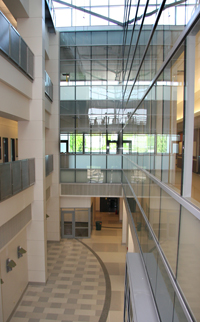Collaboration
Internal arrangements were designed with collaboration in mind:
The proximity of multi-sized classrooms, instructional laboratories, team-based project rooms, counseling areas, and informal interaction spaces creates a unique learning environment and encourages an integrated and fluid movement of people, activities, and ideas.

A good example of internal connectivity is found in the central instructional laboratory complex. Contained in this interconnected complex are a wet-bench laboratory (cell and tissue biology), an instrumentation laboratory (mechanical and electrical testing), a tissue culture facility, and a microscope darkroom (light and fluorescence). A central prep room and instructional coordinator's office link the multi-faceted learning activities scheduled for all levels of undergraduate laboratories.
Research labs are clustered along thematic lines for flexibility and synergy.
Flexible response to the continuous, fast-paced, changing needs of the medical industry and healthcare is critical to successful biomedical engineering, and to the education of tomorrow's biomedical engineers. This new facility is designed to enhance this capability for both teaching and research activities.
One example of this adaptability is the design of the "Flex Lab" instructional laboratory space. This centralized space for engineering design courses has been provided with a "dance floor" arrangement with overhead services that easily allows benches and other mobile equipment to be quickly reconfigured for the varied aspects of prototype design and testing.
